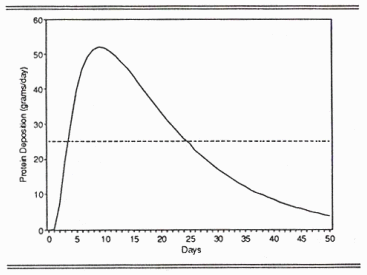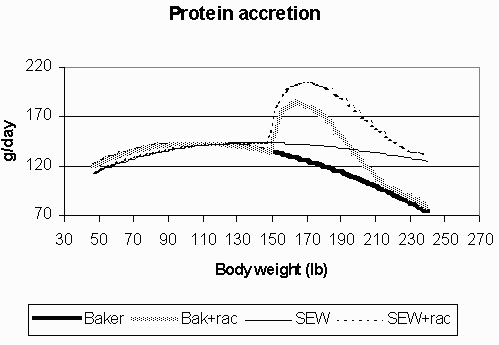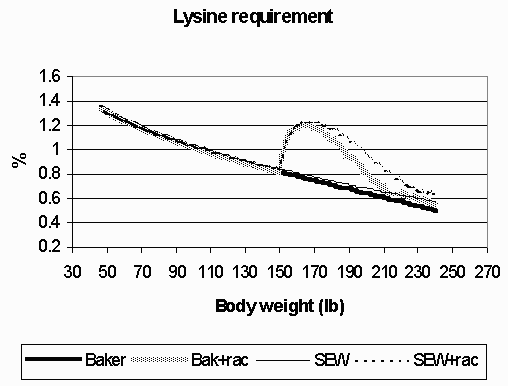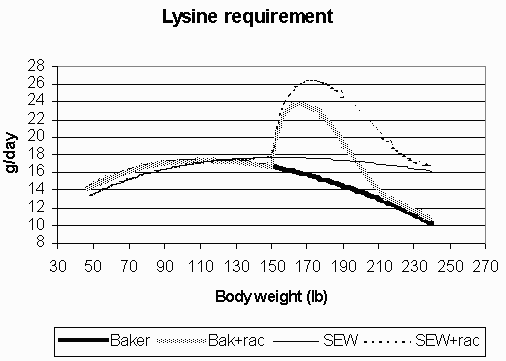
A.P. Schinckel, B.T. Richert, and D.C. Kendall
Animal Sciences Department
1
Paylean - ractopamine hydrochloride by ElancoIntroduction
Pork producers have the goal to efficiently produce lean, quality pork to compete with alternative animal products. The implementation of lean value carcass pricing systems has led to the selection of pigs with increased lean growth rates, increased carcass lean percentages and improved lean feed conversion. Health, nutrition, and facility management strategies have been implemented to increase commercially achievable lean growth rates. Paylean (ractopamine hydrochloride by Elanco) is a feed additive that has the potential to further increase the rate and efficiency of muscle tissue growth. It is a feed additive containing ractopamine hydrochloride, a small molecule that increases muscle protein growth and improves feed efficiency. Paylean has been approved to be fed at levels of 4.5 to 18 grams per ton (5 to 20 ppm) from 150 to 240 lbs live weight (last 90 lbs of live weight gain prior to slaughter). Because of increased muscle growth and protein accretion, pigs fed Paylean are expected to have increased dietary essential amino acid requirements.
The objective of this research was to review past Paylean research and develop a model of dietary lysine requirements for Paylean-fed pigs. The majority of past research trials evaluated the use of ractopamine at the 18 gram/ton level in 16% crude protein diets for the last 90 lbs of live weight gain before marketing. Paylean substantially increases the rate of muscle growth while only marginally increasing visceral, bone, and skin growth. In past trials, ractopamine increased fat-free lean gain by 34% and empty body protein accretion by 24% (Table 1). Ractopamine increased growth rate while decreasing feed intake. Tenth rib fat depth (off-midline) was reduced by 13.7% and lean mass was increased by 11%.
The magnitude of the improvements in growth and carcass traits is affected by the level of Paylean fed (Table 2). Pigs fed 4.5 g/ton Paylean grew almost as fast as the pigs fed Paylean at the 9 and 18 g/ton levels. For lean percentage and backfat depth, approximately 40 to 50% of the 18 g/ton response could be achieved by the 4.5 g/ton level. Pigs fed at the 9.0 g/ton level performed intermediate to pigs fed at the 4.5 and 18 g/ton levels.
Paylean increased daily fat-free lean gain by an average of 34% for pigs fed 20 ppm and 23.3% for pigs fed 10 ppm for the last 90 lbs of live weight gain before slaughter. The percentage lean growth responses to Paylean are consistent across genotypes with different lean growth potentials. In two studies consisting of seven genotypes with substantially different lean growth rates, feeding 20 ppm Paylean resulted in a consistent 34% increase in lean gain regardless of genotype. Therefore, greater Paylean lean growth responses will occur in pigs of high lean growth genotypes.
Ractopamine research has shown that the lean growth response to ractopamine is not constant over the entire 90 lb gain feeding period. The response increases, reaches a plateau, and then declines (Figure 1). The maximum response is achieved at 22 to 26 lbs of live weight gain or approximately 10 to 14 days on Paylean (20 ppm) supplemented feed.
Modeling the Paylean Response
Five parameters were taken into account when modeling the effects of Paylean.
The model assumes a constant percent average increase in protein accretion. Thus the Paylean response is greater at the heavier weights in the SEW environment. The predicted grams of dietary lysine are higher for gilts fed Paylean and gilts in the SEW environment after 150 lbs live weight (Figure 3). The predicted percent lysine was similar for gilts in the two environments. The increased daily lysine requirement of the SEW gilts was offset by their higher feed intakes (Figure 4), such that the SEW and CF gilts had similar percent lysine requirements.
The predicted percent lysine requirement for pigs fed 18 g/ton Paylean rapidly increases, reaches a plateau during the second and third week of feeding Paylean, and then rapidly declines (Table 3). Phase feeding will be required if the lysine requirements are to be closely met. If instead the average predicted lysine requirement is fed, pigs will not achieve the maximum performance during the period of peak potential Paylean response, and lysine will be overfed during the period of decreased Paylean response.
The model can predict the weekly lysine requirements for feeding different levels of Paylean. Pigs fed 9 g/ton of Paylean do not have as high predicted lysine requirements as pigs fed 18 g/ton Paylean. The maximal increase in dietary lysine percentage is 50 to 58% for gilts fed 18 g/ton Paylean and 32 to 37% for pigs fed 9 g/ton Paylean (Table 3). The model indicates that producers should consider phase feeding with 2 or 3 diets of different % lysine with either the 9 or 18 g/ton levels of Paylean.
Implications
Paylean can substantially improve the rate and efficiency of lean growth. Producers should consider phase feeding diets higher in percent lysine than typically fed to finishing pigs.
Reference
Kendall, D.C., B.T. Richert, T.E. Weber, K.A. Bowers, S.A. DeCamp, A.P. Schinckel, and P. Matzat. 2000. Evaluation of pig genotype, strategic use of antibiotics and grow-finish management effects on lean growth rate and carcass characteristics. Purdue University Swine Day Report. p. 60.
Table 1. Summary of ractopamine responsea.
|
|
Percent |
|
Increased fat-free lean growth |
34.0% |
|
Increased protein accretion |
24.0% |
|
Decreased feed intake |
5.5% |
|
Increased ADG |
8.9% |
|
Improved F/G |
14.2% |
|
Reduced backfat thickness |
13.7% |
|
Increased carcass lean mass |
11.1% |
|
Increased dressing percent |
1.5% |
a
18.5 g/ton (20 ppm) level for the last 90 lbs of live weight gain.
Table 2. Impact of ractopamine level on pig growth and carcass measurementa.
|
|
Ractopamine Level, g/ton |
|||
|
|
0 |
4.5 |
9.0 |
18.0 |
|
ADG, lbs/day |
1.80 |
1.98 |
1.99 |
2.01 |
|
ADFI, lbs/day |
3.06 |
3.06 |
2.97 |
2.98 |
|
Feed/Gain |
3.70 |
3.41 |
3.36 |
3.28 |
|
Dressing Percent |
72.1 |
72.5 |
72.7 |
73.0 |
|
10th Rib Fat Depth, in. |
.99 |
.94 |
.92 |
.87 |
|
LEA, in2 |
5.15 |
5.55 |
5.70 |
5.84 |
|
% Dissected Lean |
52.8 |
55.5 |
-- |
58.2 |
|
% Dissected Fat |
27.1 |
25.2 |
-- |
23.0 |
a
Watkins et al., 1988, 6 trials, 888 pigs.
Table 3. Predicting weekly lysine requirements for three levels of Paylean (ppm) in two environments.
|
|
Continuous Flow |
SEW High Health |
||||||||
|
Level of |
|
|
% |
|
% |
|
|
% |
|
% |
|
Week 1 |
.79 |
1.00 |
27.2 |
1.13 |
42.7 |
.81 |
1.02 |
25.4 |
1.14 |
39.8 |
|
2 |
.74 |
1.02 |
37.3 |
1.17 |
58.4 |
.77 |
1.06 |
37.4 |
1.22 |
58.6 |
|
3 |
.70 |
.92 |
32.4 |
1.05 |
50.6 |
.72 |
.97 |
34.5 |
1.11 |
53.9 |
|
4 |
.66 |
.80 |
21.5 |
.88 |
33.7 |
.68 |
.85 |
25.0 |
.95 |
39.2 |
|
5 |
.62 |
.69 |
11.4 |
.73 |
18.3 |
.64 |
.74 |
14.9 |
.79 |
23.7 |
|
6 |
.58 |
.62 |
6.5 |
.65 |
10.8 |
.60 |
.65 |
7.7 |
.68 |
12.7 |
|
7 |
.55 |
.58 |
6.5 |
.61 |
10.8 |
|
|
|
|
|

Figure 1. Increase in maximum protein deposition due to ractopamine fed at 20 ppm.

Figure 2. Protein accretion (g/day) for continuous flow (Baker) and SEW environments, with and without ractopamine.

Figure 3. Lysine requirement (%) for continuous flow (Baker) and SEW environments, with and without ractopamine.

Figure 4. Lysine requirement (g/day) for continuous flow (Baker) and SEW environments, with and without ractopamine.